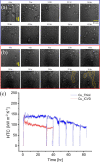Ultrathin Durable Organic Hydrophobic Coatings Enhancing Dropwise Condensation Heat Transfer
- PMID: 36037308
- PMCID: PMC9494938
- DOI: 10.1021/acs.langmuir.2c01477
Ultrathin Durable Organic Hydrophobic Coatings Enhancing Dropwise Condensation Heat Transfer
Abstract
Organic hydrophobic layers targeting sustained dropwise condensation are highly desirable but suffer from poor chemical and mechanical stability, combined with low thermal conductivity. The requirement of such layers to remain ultrathin to minimize their inherent thermal resistance competes against durability considerations. Here, we investigate the long-term durability and enhanced heat-transfer performance of perfluorodecanethiol (PFDT) coatings compared to alternative organic coatings, namely, perfluorodecyltriethoxysilane (PFDTS) and perfluorodecyl acrylate (PFDA), the latter fabricated with initiated chemical vapor deposition (iCVD), in condensation heat transfer and under the challenging operating conditions of intense flow (up to 9 m s-1) of superheated steam (111 °C) at high pressures (1.42 bar). We find that the thiol coating clearly outperforms the silane coating in terms of both heat transfer and durability. In addition, despite being only a monolayer, it clearly also outperforms the iCVD-fabricated PFDA coating in terms of durability. Remarkably, the thiol layer exhibited dropwise condensation for at least 63 h (>2× times more than the PFDA coating, which survived for 30 h), without any visible deterioration, showcasing its hydrolytic stability. The cost of thiol functionalization per area was also the lowest as compared to all of the other surface hydrophobic treatments used in this study, thus making it the most efficient option for practical applications on copper substrates.
Conflict of interest statement
The authors declare no competing financial interest.
Figures




References
-
- Attinger D.; Frankiewicz C.; Betz A. R.; Schutzius T. M.; Ganguly R.; Das A.; Kim C.-J.; Megaridis C. M. Surface Engineering for Phase Change Heat Transfer: A Review. MRS Energy Sustainable 2014, 1, 1–40. 10.1557/mre.2014.9. - DOI
-
- Enright R.; Miljkovic N.; Alvarado J. L.; Kim K.; Rose J. W. Dropwise Condensation on Micro-and Nanostructured Surfaces. Nanoscale Microscale Thermophys. Eng. 2014, 18, 223–250. 10.1080/15567265.2013.862889. - DOI
-
- Cho H. J.; Preston D. J.; Zhu Y.; Wang E. N. Nanoengineered Materials for Liquid-Vapour Phase-Change Heat Transfer. Nat. Rev. Mater. 2017, 2, 1–17. 10.1038/natrevmats.2016.92. - DOI
-
- Edalatpour M.; Liu L.; Jacobi A. M.; Eid K. F.; Sommers A. D. Managing Water on Heat Transfer Surfaces: A Critical Review of Techniques to Modify Surface Wettability for Applications with Condensation or Evaporation. Appl. Energy 2018, 222, 967–992. 10.1016/j.apenergy.2018.03.178. - DOI

